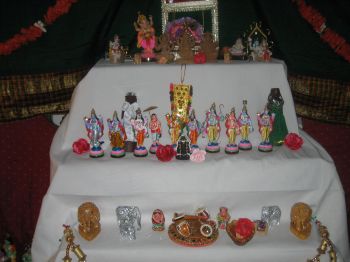To experience spicy food, vibrant colors, foot tapping Bollywood music and traditional Indian arts, music and crafts, you don’t have to travel to India. Although, celebrating Diwali in India has its own magic, you can experience the spirit of the season almost anywhere in the world. Many cities in the US, UK, Canada and other western countries that have a considerable Indian population, host Diwali celebrations in one form or another. Some of them are quite spectacular, not very different from July 4th celebrations.
This Diwali, if you can’t make it to India, be sure to check out what your city has in store. There’s sure to be a Diwali Mela somewhere in your city or in a neighboring city. Take some time off to enjoy India’s biggest festival with your family and don’t forget to send free Diwali ecards to your friends and family.
- Atlanta : Oct 9 2009 : Win a diamond ring for Diwali! Enjoy an evening of fun, food and fireworks with your family at Festival of Lights – A cultural Extravaganza, a program organized by DesiRoots. Celebrations include cultural performances, food stalls, shops, games and fireworks, starting at 5 pm. Please note: this program was initially scheduled for Sep 18, but has been postponed to Oct 9 due to inclement weather in Atlanta. So, don’t miss this second chance! Who knows – you may even walk out with a diamond ring. http://www.desiroots.net/
- Dallas : Oct 4th 2009 : How would you like to celebrate Diwali in the state-of-the-art Cowboys stadium? This year, if you truly want to experience the grandeur and spectacular nature of Diwali celebrations, then don’t miss the Diwali Mela 2009 in Arlington, TX. Programs and activities include cultural performances including a special Ram Leela production, kids games, magic shows, animal rides and raas, garba dances in which you can participate with your family. http://www.dfwdiwalimela.com/
- San Francisco Bay Area: Experience the most colorful aspects of India and the festival of lights, by making it to the Cupertino Diwali celebrations. Highlights include dance performances from various parts of India, Bollywood dances, kids’ shows, animal rides, games, wood workshops, coloring contests, Mehendi or henna booths, food courts, Indian bazaars and handicraft displays. http://www.sfgate.com/cgi-bin/article.cgi?f=/c/a/2009/09/23/NSUC19OO4H.DTL
- San Francisco, Oct 9-11: How would you like to be transported to India, just for Diwali? There is a chance that this will happen if you participate in the Sunnyvale Hindu Temple Diwali celebrations. Slated to be the biggest Diwali event of Bay Area, this 3-day long festival features classical concerts by seasoned musicians and performances by local artists. Other programs include cultural performances, talent shows and games like Antakshari in which you can participate with your family. Food booths and handicrafts displays enrich your experience as you celebrate the festival of lights in sunny California.http://www.sunnyvaletemple.org/diwali2009.htm.
- Vancouver, Oct 18 – 12-7 pm : If you’re in Vancouver and wish to experience the fervor of Diwali, then mark your calendar right now – Downtown Diwali – is an event like none other. A day-long extravaganza that combines the finest elements of traditional, classical South Asian arts with contemporary, fusion forms. The event promotes local South Asian artists, presenting performances in various styles – Bharatnatyam, Bhangra, Hindustani, Bollywood, Jazz, fusion, hip hop. Besides Downtown Diwali, several other arts and culture workshops and performances will take place throughout the month at various locations. These include Diya or lamp painting workshops, workshops that teach the art of wearing a sari and others. So, this Diwali season, experience a slice of India in Vancouver. http://www.vandiwali.ca/events/
So, where will you be celebrating Diwali this year?
And be sure to upload a picture from the Diwali Mela you go to and create a free photo ecard to share with your friends and family.

 Have you sent out
Have you sent out 
